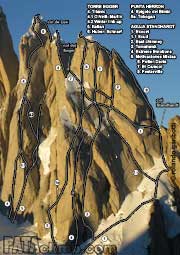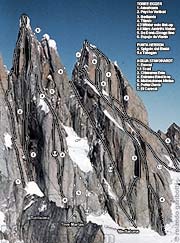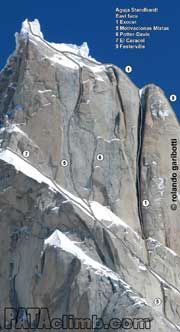1.1 SCUD / DESARMADA
300m WI4 M6 6b+
Txema Egizabal and Xavi Ansa (Euskadi), 1987, were the first to climb those 300m; Kevin Thaw (UK) and Mark Synnott (USA), 1998, repeated this line to the juncture with Exocet from where they retreated (Exocet was established soon after Ansa and Egizabal's attempt); Robert Caspersen, Ole Lied and Trym Atle Sæland (Norway) 11/2013, climbed the line to the summit.
Description. This variation provides an alternate start to Exocet. It climbs an obvious left facing corner that leads to the snowramps at the base of the Exocet chimney. This line is commonly used as the Exocet descent line.
The climbing is reported to be excellent. There are several really good slab climbing sections and almost every pitch involves some mixed climbing, so don't be surprised if you keep your crampons on the entire time. That said, it is possible that late in the season or during a dry season, this climb might be done as a rock climb, climbing it entirely in rock shoes.
History. Although the name Exocet had a deeper meaning beyond the missile theme, the subject has stuck to the face. SCUD is the name of a Soviet missile.
Integral ascent and free ascent. In 2013 Robert Caspersen, Ole Lied and Trym Atle Sæland climbed the route to the summit, doing the first integral ascent while onsight free climbing every pitch. They proposed naming the route "Desarmada", playing upon the already set theme of this section on Standhardt. By making the first ascent to the summit of this line they disarmed the earlier “attempt” named “Scud”. Making the climb free of aid underscore the disarming.
History and "new route concept" discussion. Egizabal and Ansa climbed the "unique portion" of this route when Aguja Standhardt was still a virgin summit, climbing virgin ground in the lower 300 meters to then join the British attempt line, climbing a further 300 meters to reach a point 150 meters from the summit in the upper south face. Synnot and Thaw climbed only the lower 300 meters before retreating, but they joined Exocet, which had been established to the summit soon after Ansa and Egizabal's attempt (it should be noted that Synott and Thaw did not know about Ansa and Egizabal's ascent). Although Synott and Thaw climbed no new ground, first ascent credit has gone to them. The reason for this is because in this area there is a long tradition of deeming a route complete if it joins an existing line, even if the climbers involved do not continue on to the summit. This long tradition dates back to the first ascent of Diedro del Diablo on Cerro Fitz Roy, likely the first climb in this area that was claimed as a new route having joined an existing line but not reaching an actual summit. This was followed by many other routes, including major climbs, some of the hardest in the area, routes such as: Cerro Torre's Cara Sur, Infinito Sud, What's love got to do with it, Chimichurri y Tortas Fritas, Historia Interminable, Royal Flush, etc. These climbs set an accepted pattern and in the late 1990s this was, for better or for worse, defined as the local standard. So as to underline the importance of ascents to the summit the concept of "Integral Ascent" was introduced (this happened within the context of reporting for High Magazine's Mountain Info section and the American Alpine Journal, with Christian Beckwith and Lindsay Griffin as editors and Rolando Garibotti as one of the key correspondents).
Note that there is a long tradition in the Alps of considering a line that joins an existing route "a new route" even if the climbers that open it do not continue on to the summit. This is a less prevalent concept in North America where reaching the summit is considered an integral and important part of any ascent. Robert Caspersen believes that routes should be considered climbed only when they reach the summit. Dean Potter pointed out the same back in the late 1990s and Colin Haley, the most active climber in the area today, also agrees. Was it a mistake to accept this "joined-existing-line-no-summit-new-route-concept" as "valid"? Should this be revised?
In the late 1990s there were several new route claims without summit that stretched the concept well beyond joining existing routes, with claims of joining phantom routes, claims to have reached geographical features that are ill defined or invented and even new route claims for climbs that stop in the middle of a wall. In this website, in many of these last cases the routes are not listed as new routes but as attempts.
Approach. De Agostini to Niponino then up the valley.
Descent. Exocet.
Bibliography. Desnivel magazine 36 p. 4-10. |


